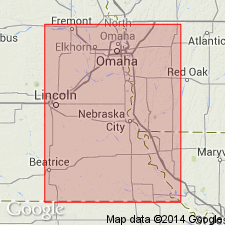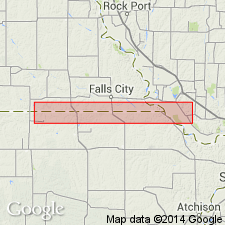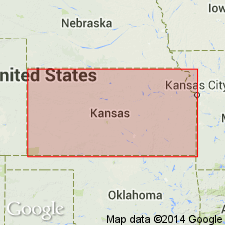
- Usage in publication:
-
- Glenrock limestone bed
- Modifications:
-
- Original reference
- Dominant lithology:
-
- Limestone
- AAPG geologic province:
-
- Forest City basin
Summary:
Pg. 84, 86, 88. Glenrock limestone bed of Elmdale shale member of Wabaunsee formation. Dark gray, dense limestone; weathers light gray or slightly buff. Thickness 1 to 2 feet in Nebraska and northeastern Kansas. Underlies Bennett shale and overlies Johnson shale, all included in Elmdale shale member. Age is Late Pennsylvanian (Missouri age). Report includes cross sections, measured sections, geologic maps, stratigraphic tables.
Named from exposures high in valley side just northwest of Glenrock, Nemaha Co., southeastern NE.
Source: US geologic names lexicon (USGS Bull. 896, p. 829); GNC KS-NE Pennsylvanian Corr. Chart, sheet 1, Oct. 1936; supplemental information from GNU records (USGS DDS-6; Denver GNULEX).

- Usage in publication:
-
- Glenrock limestone member
- Modifications:
-
- Revised
- AAPG geologic province:
-
- Forest City basin
Summary:
Pg. 8. Glenrock limestone member of Red Eagle limestone formation of Council Grove group. Thickness 1 foot to 1 foot 8 inches. Occurs below Bennett shale member of Red Eagle and above Johnson shale formation of Council Grove group. Age is considered Permian (lower part of Big Blue). [See also under Howe.]
Source: US geologic names lexicon (USGS Bull. 896, p. 829, Howe entry p. 987); GNC KS-NE Pennsylvanian Corr. Chart, sheet 2, Oct. 1936.

- Usage in publication:
-
- Glenrock limestone member
- Modifications:
-
- Age modified
- AAPG geologic province:
-
- Forest City basin
Summary:
Glenrock limestone member of Red Eagle limestone of Council Grove group. Transferred this unit to Permian (Big Blue series). This change in Permian-Pennsylvanian boundary has not been considered by the USGS for its publications [ca. 1938].
Source: US geologic names lexicon (USGS Bull. 896, p. 829); GNC KS-NE Pennsylvanian Corr. Chart, sheet 2, Oct. 1936.

- Usage in publication:
-
- Glenrock limestone member
- Modifications:
-
- Overview
Summary:
Pg. 48. Glenrock limestone member of Red Eagle limestone. Consists of gray and brown limestone, impure in northern part of outcrop area, purer in central and northern part; fusulines common. Thickness in northern part of Kansas 1 to 2 feet; in central Kansas as much as 19 feet. Underlies Bennett shale member; overlies Johnson shale. Age is Early Permian (Wolfcamp).
Source: US geologic names lexicon (USGS Bull. 1200, p. 1527).
For more information, please contact Nancy Stamm, Geologic Names Committee Secretary.
Asterisk (*) indicates published by U.S. Geological Survey authors.
"No current usage" (†) implies that a name has been abandoned or has fallen into disuse. Former usage and, if known, replacement name given in parentheses ( ).
Slash (/) indicates name conflicts with nomenclatural guidelines (CSN, 1933; ACSN, 1961, 1970; NACSN, 1983, 2005, 2021). May be explained within brackets ([ ]).

